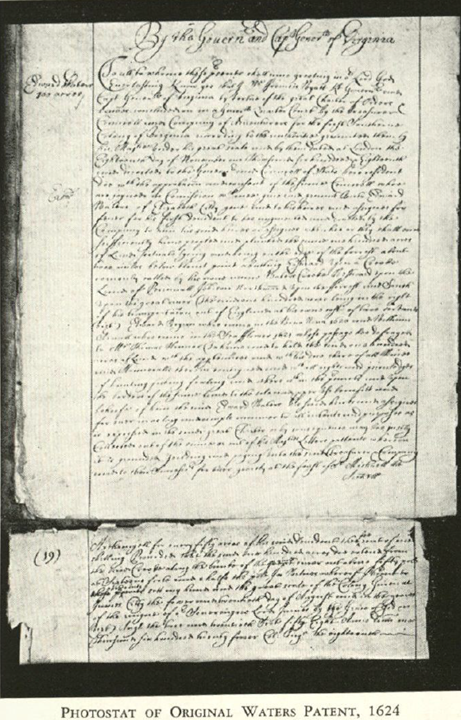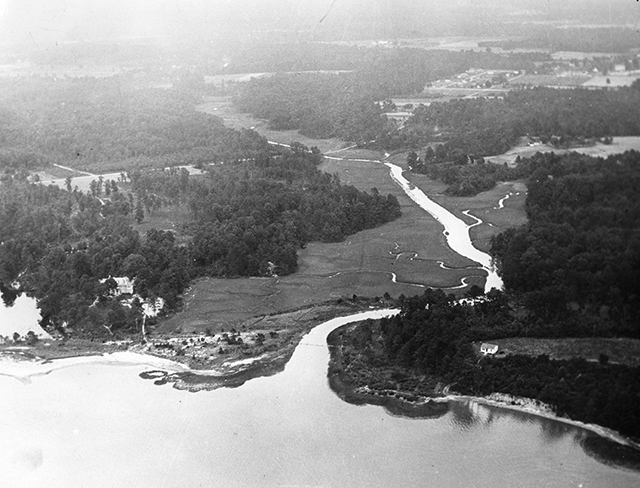
It’s been a big announcement week here at The Mariners’ Museum and Park. This will be the fifth, or sixth, English, name change for the water running through the Park. If you didn’t see the CEO’s announcement of name change earlier this week, check it out here. But today, I wanna throw it way, way back and talk about the origin of the water’s first English name (notice that I am clarifying this first name as “English” because the Native Americans living in the area most definitely had a different name for the water before English settlement in the early seventeenth century).
In 1624, 100 acres of land around Water’s Creek, seven miles up the James River from Newport News Point, was patented to Edward Waters; although there is evidence that Waters and his wife had been living on the land for five years prior. While he was not the only Englishman granted land near this water, he was the first, and therefore, the namesake. And while calling the water “Waters lake” or “Waters water” would sound kinda silly and redundant; Edward Waters has a really cool maritime history, making him easy to interpret in relation to the Museum’s mission.

Born in 1585, Edward Waters was part of the crew of Sea Venture, en route to the Virginia colonies in 1609 with eight other ships carrying hopeful English emigrants. Sea Venture was captained by Christopher Newport, and notably carried Sir Thomas Gates, the newly appointed Lieutenant-Governor; John Rolfe; William Strachey, the colony’s future secretary; and Sir George Somers, the fleet’s admiral. While most of the trip was uneventful, the fleet hit a bad storm while only a week away from the Virginia colony and Sea Venture was separated from the other vessels. Four days later, Sea Venture and its 150, or so, passengers purposefully wrecked on Bermuda.
For the next 10 months, the survivors hunted, fished, and lived on Bermuda, which was then known to the English as “The Devil’s Island”, while salvaging materials from Sea Venture to build new transportation. In the end, they ended up with two smaller ships – Deliverance and Patience. Edward Waters and George Somers sailed to Virginia on Patience. The trip took them ten days. On May 10, 1610, Deliverance and Patience and all the survivors, except two mutineers who were left on Bermuda, entered the Chesapeake Bay. While this is not the end of this saga, Jamestown Fort was not in good shape when Deliverance and Patience arrived, it is the most important part of Water’s story.
Water’s chose, not long after that, to return to Bermuda and help with the establishment of a legitimate British colony there. This colony became a vital trade partner to the Virginia colony. Waters commanded a ship on supply voyage from Bermuda to the West Indies in 1615. And then about 1618, Water’s decided to move to Virginia permanently. This appears to be the same time frame in which he got married to Grace O’Neil and took up residence near Water’s Creek.
So, there you go, the first English name for our waterway was named after a mariner, which, if you think about it, is pretty cool. AND, this isn’t even Waters’ whole story! There is more, but of course, we need blog content for another day, so I’ll save it for later.

How did the English name of the water change, you may ask? Sometime in the mid-nineteenth century, a geodetic surveyor incorrectly labeled Water’s Creek as Watts Creek. The resulting survey map was widely published and permanently re-named the creek. Also, in the eighteenth century, the water on the North side of (what is today) Warwick Boulevard was damned and became known as “the mill pond”, and later “Causey’s Mill Pond”. Then, again, in the early 1930s when creating The Mariners’ Museum and Park the founder(s), renamed the water. They were, after all, damming the creek and making it a lake. It needed a lake name. They called it Lake Maury. This change encompassed both Causey’s Mill Pond and the flooded area around Watts Creek. Name change is not new, but by studying the previous versions we better understand where we came from. In this case, straight from an English mariner!